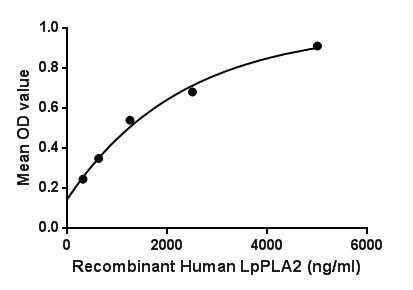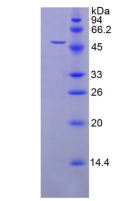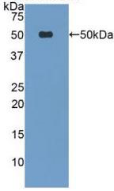
Details
ACTIVITY TEST
Buffer Formulation 20mM Tris, 150mM NaCl, pH8.0, containing 1mM EDTA, 1mM DTT, 0.01% SKL, 5% Trehalose and Proclin300. Traits Freeze-dried powder Purity > 90% Isoelectric Point 7.1 Applications Cell culture; Activity Assays.

Figure. The binding activity of LpPLA2 with PTPRN.
Phospholipase A2, Lipoprotein Associated (LpPLA2) also known as platelet-activating factor acetylhydrolase (PAF-AH) is a phospholipase A2 enzyme. LpPLA2 is platelet-activating factor (PAF) acetylhydrolase, a secreted enzyme that catalyzes the degradation of PAF to inactive products by hydrolysis of the acetyl group at the sn-2 position, producing the biologically inactive products LYSO-PAF and acetate. Besides, Protein Tyrosine Phosphatase Receptor Type N (PTPRN) has been identified as an interactor of LpPLA2, thus a binding ELISA assay was conducted to detect the interaction of recombinant human LpPLA2 and recombinant human PTPRN. Briefly, LpPLA2 were diluted serially in PBS, with 0.01% BSA (pH 7.4). Duplicate samples of 100uL were then transferred to PTPRN-coated microtiter wells and incubated for 2h at 37℃. Wells were washed with PBST and incubated for 1h with anti-LpPLA2 pAb, then aspirated and washed 3 times. After incubation with HRP labelled secondary antibody, wells were aspirated and washed 3 times. With the addition of substrate solution, wells were incubated 15-25 minutes at 37℃. Finally, add 50µL stop solution to the wells and read at 450nm immediately. The binding activity of LpPLA2 and PTPRN was shown in Figure 1, and this effect was in a dose dependent manner.USAGE
Reconstitute in 20mM Tris, 150mM NaCl (pH8.0) to a concentration of 0.1-1.0 mg/mL. Do not vortex.
STORAGE
Avoid repeated freeze/thaw cycles. Store at 2-8°C for one month. Aliquot and store at -80°C for 12 months.
STABILITY
The thermal stability is described by the loss rate. The loss rate was determined by accelerated thermal degradation test, that is, incubate the protein at 37°C for 48h, and no obvious degradation and precipitation were observed. The loss rate is less than 5% within the expiration date under appropriate storage condition.
Image

Figure. Gene Sequencing (Extract)
Image

Figure. SDS-PAGE

Figure. Western Blot
Bought notes(bought amounts latest0)
User Comment(Total0User Comment Num)
- No comment


 +86 571 56623320
+86 571 56623320 SALES@SUNLONGBIOTECH.COM
SALES@SUNLONGBIOTECH.COM +86 18668110335
+86 18668110335

